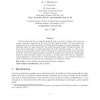354 search results - page 21 / 71 » The Chromatic Number Of Graph Powers |
DM
2010
13 years 9 months ago
2010
Let Mad(G) denote the maximum average degree (over all subgraphs) of G and let i(G) denote the injective chromatic number of G. We prove that if Mad(G) 5 2 , then i(G) + 1; sim...
JCO
2007
13 years 9 months ago
2007
We consider the problem of orienting the edges of a graph so that the length of a longest path in the resulting digraph is minimum. As shown by Gallai, Roy and Vitaver, this edge ...
SIAMDM
2008
13 years 9 months ago
2008
We first show that for any bipartite graph H with at most five vertices, there exists an on-line competitive algorithm for the class of H-free bipartite graphs. We then analyze th...
CORR
2006
Springer
13 years 9 months ago
2006
Springer
The independence numbers of powers of graphs have been long studied, under several definitions of graph products, and in particular, under the strong graph product. We show that t...
DAM
2011
13 years 4 months ago
2011
An arc of a graph is an oriented edge and a 3-arc is a 4-tuple (v, u, x, y) of vertices such that both (v, u, x) and (u, x, y) are paths of length two. The 3-arc graph of a graph ...

